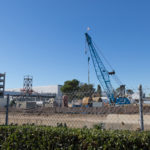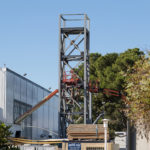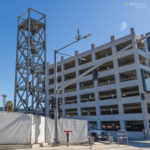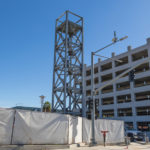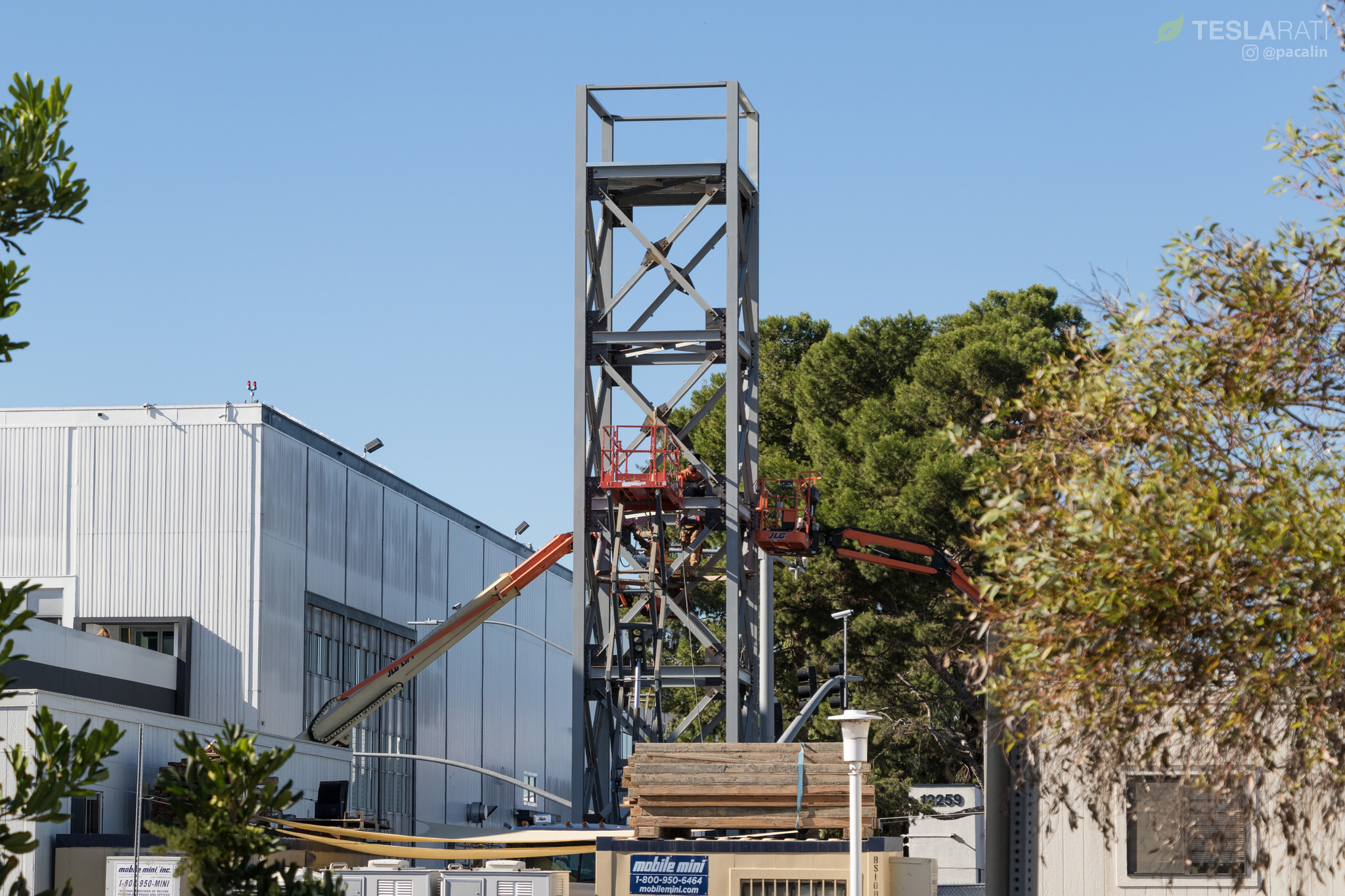

News
The Boring Company starts building Elon Musk’s ‘Monty Python’-style watchtower
Last month, Elon Musk announced that The Boring Company is building a watchtower in Los Angeles, and that the tunneling startup would need someone who can “yell insults at people in a French accent” to work on the site. As strange and unusual as the job listing was, a position for “Watchtower Guard” did appear on the Boring Company’s official website.
The watchtower that the knight would be placed at is expected to be built with Boring Bricks, which are durable, low-cost blocks made from tunneling rock and dirt from TBC’s digging operations. As Elon Musk and The Boring Company shared images and clips of the guards’ hiring process, the tunneling startup appears to have started the construction of its watchtower as well. Recent photos taken by Teslarati photographer Pauline Acalin reveal that as of Tuesday, the framework of a tall structure near the Boring Company’s tunnels is already in the process of being built.
- The Boring Company’s watchtower starts taking shape. [Credit: Pauline Acalin/Teslarati]
- The Boring Company’s watchtower starts taking shape. [Credit: Pauline Acalin/Teslarati]
- The Boring Company’s watchtower starts taking shape. [Credit: Pauline Acalin/Teslarati]
The Boring Company’s watchtower starts taking shape. [Credit: Pauline Acalin/Teslarati]
Musk’s recent tweets and the Boring Company’s job opening are yet another display of the SpaceX and Tesla CEO’s love for pop culture. The watchtower guard job listing, after all, is a direct reference to the knight played by actor John Cleese in 1975’s Monty Python and the Holy Grail, a classic film widely regarded as one of the funniest movies ever made. In one of the film’s most memorable scenes, a sharp-tongued French guard taunted King Arthur by hurling multiple insults from the top of a castle wall.
If the metal framework for the structure is any indication, it appears that The Boring Company’s watchtower would be quite tall. This could be seen in photos showing the watchtower easily matching the height of a nearby multi-story building. The construction of the tower seems to be in its initial stages, though, as the Boring Bricks are yet to be overlaid on the structure.
- The Boring Company’s watchtower starts taking shape. [Credit: Pauline Acalin/Teslarati]
- The Boring Company’s watchtower starts taking shape. [Credit: Pauline Acalin/Teslarati]
- The Boring Company’s watchtower starts taking shape. [Credit: Pauline Acalin/Teslarati]
The Boring Company’s watchtower starts taking shape. [Credit: Pauline Acalin/Teslarati]
Elon Musk’s companies always carry a little bit of fun and playfulness. Tesla’s electric cars, for one, are loaded with features such as fun Easter Eggs and references to pop culture, as shown in Autopilot’s “Mad Max” setting and a volume bar that maxes out at 11 — a direct reference to This is Spinal Tap. The same is true for SpaceX, with the red Tesla Roadster that was sent to space on the Falcon Heavy’s maiden voyage being loaded to the brim with sci-fi references. With these in mind, The Boring Company’s nods to Monty Python and the Holy Grail in the form of an insult-hurling French-accented watchtower guard could be described as classic Elon Musk.
Considering the watchtower’s state as of Tuesday though, there seems to be a pretty slim chance that the structure would be completed by December 10, the date set by The Boring Company for the public opening of the recently-finished Hawthorne test tunnel. In a Twitter announcement, Musk stated that the test tunnel will have an opening event on the night of December 10, and by December 11, free rides through the tunnel system would be offered to the public.
The Boring Company’s activities in Hawthorne have been ramping recently. Apart from the test tunnel that would soon be opened to the public, work is also being done in the company’s Prairie Ave. site, which hosts TBC’s prototype garage-elevator concept. In a nearby location, images taken by Teslarati photographers suggest that a tunnel boring machine gantry is under construction as well.
Watch the iconic Monty Python watchtower guard scene in the video below.

Elon Musk
Elon Musk and Tesla AI Director share insights after empty driver seat Robotaxi rides
The executives’ unoccupied tests hint at the rapid progress of Tesla’s unsupervised Robotaxi efforts.

Tesla CEO Elon Musk and AI Director Ashok Elluswamy celebrated Christmas Eve by sharing personal experiences with Robotaxi vehicles that had no safety monitor or occupant in the driver’s seat. Musk described the system’s “perfect driving” around Austin, while Elluswamy posted video from the back seat, calling it “an amazing experience.”
The executives’ unoccupied tests hint at the rapid progress of Tesla’s unsupervised Robotaxi efforts.
Elon and Ashok’s firsthand Robotaxi insights
Prior to Musk and the Tesla AI Director’s posts, sightings of unmanned Teslas navigating public roads were widely shared on social media. One such vehicle was spotted in Austin, Texas, which Elon Musk acknowleged by stating that “Testing is underway with no occupants in the car.”
Based on his Christmas Eve post, Musk seemed to have tested an unmanned Tesla himself. “A Tesla with no safety monitor in the car and me sitting in the passenger seat took me all around Austin on Sunday with perfect driving,” Musk wrote in his post.
Elluswamy responded with a 2-minute video showing himself in the rear of an unmanned Tesla. The video featured the vehicle’s empty front seats, as well as its smooth handling through real-world traffic. He captioned his video with the words, “It’s an amazing experience!”
Towards Unsupervised operations
During an xAI Hackathon earlier this month, Elon Musk mentioned that Tesla owed be removing Safety Monitors from its Robotaxis in Austin in just three weeks. “Unsupervised is pretty much solved at this point. So there will be Tesla Robotaxis operating in Austin with no one in them. Not even anyone in the passenger seat in about three weeks,” he said. Musk echoed similar estimates at the 2025 Annual Shareholder Meeting and the Q3 2025 earnings call.
Considering the insights that were posted Musk and Elluswamy, it does appear that Tesla is working hard towards operating its Robotaxis with no safety monitors. This is quite impressive considering that the service was launched just earlier this year.
Elon Musk
Starlink passes 9 million active customers just weeks after hitting 8 million
The milestone highlights the accelerating growth of Starlink, which has now been adding over 20,000 new users per day.

SpaceX’s Starlink satellite internet service has continued its rapid global expansion, surpassing 9 million active customers just weeks after crossing the 8 million mark.
The milestone highlights the accelerating growth of Starlink, which has now been adding over 20,000 new users per day.
9 million customers
In a post on X, SpaceX stated that Starlink now serves over 9 million active users across 155 countries, territories, and markets. The company reached 8 million customers in early November, meaning it added roughly 1 million subscribers in under seven weeks, or about 21,275 new users on average per day.
“Starlink is connecting more than 9M active customers with high-speed internet across 155 countries, territories, and many other markets,” Starlink wrote in a post on its official X account. SpaceX President Gwynne Shotwell also celebrated the milestone on X. “A huge thank you to all of our customers and congrats to the Starlink team for such an incredible product,” she wrote.
That growth rate reflects both rising demand for broadband in underserved regions and Starlink’s expanding satellite constellation, which now includes more than 9,000 low-Earth-orbit satellites designed to deliver high-speed, low-latency internet worldwide.
Starlink’s momentum
Starlink’s momentum has been building up. SpaceX reported 4.6 million Starlink customers in December 2024, followed by 7 million by August 2025, and 8 million customers in November. Independent data also suggests Starlink usage is rising sharply, with Cloudflare reporting that global web traffic from Starlink users more than doubled in 2025, as noted in an Insider report.
Starlink’s momentum is increasingly tied to SpaceX’s broader financial outlook. Elon Musk has said the satellite network is “by far” the company’s largest revenue driver, and reports suggest SpaceX may be positioning itself for an initial public offering as soon as next year, with valuations estimated as high as $1.5 trillion. Musk has also suggested in the past that Starlink could have its own IPO in the future.
News
NVIDIA Director of Robotics: Tesla FSD v14 is the first AI to pass the “Physical Turing Test”
After testing FSD v14, Fan stated that his experience with FSD felt magical at first, but it soon started to feel like a routine.

NVIDIA Director of Robotics Jim Fan has praised Tesla’s Full Self-Driving (Supervised) v14 as the first AI to pass what he described as a “Physical Turing Test.”
After testing FSD v14, Fan stated that his experience with FSD felt magical at first, but it soon started to feel like a routine. And just like smartphones today, removing it now would “actively hurt.”
Jim Fan’s hands-on FSD v14 impressions
Fan, a leading researcher in embodied AI who is currently solving Physical AI at NVIDIA and spearheading the company’s Project GR00T initiative, noted that he actually was late to the Tesla game. He was, however, one of the first to try out FSD v14.
“I was very late to own a Tesla but among the earliest to try out FSD v14. It’s perhaps the first time I experience an AI that passes the Physical Turing Test: after a long day at work, you press a button, lay back, and couldn’t tell if a neural net or a human drove you home,” Fan wrote in a post on X.
Fan added: “Despite knowing exactly how robot learning works, I still find it magical watching the steering wheel turn by itself. First it feels surreal, next it becomes routine. Then, like the smartphone, taking it away actively hurts. This is how humanity gets rewired and glued to god-like technologies.”
The Physical Turing Test
The original Turing Test was conceived by Alan Turing in 1950, and it was aimed at determining if a machine could exhibit behavior that is equivalent to or indistinguishable from a human. By focusing on text-based conversations, the original Turing Test set a high bar for natural language processing and machine learning.
This test has been passed by today’s large language models. However, the capability to converse in a humanlike manner is a completely different challenge from performing real-world problem-solving or physical interactions. Thus, Fan introduced the Physical Turing Test, which challenges AI systems to demonstrate intelligence through physical actions.
Based on Fan’s comments, Tesla has demonstrated these intelligent physical actions with FSD v14. Elon Musk agreed with the NVIDIA executive, stating in a post on X that with FSD v14, “you can sense the sentience maturing.” Musk also praised Tesla AI, calling it the best “real-world AI” today.

